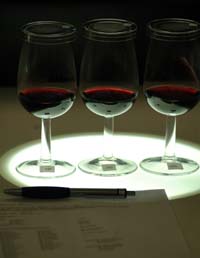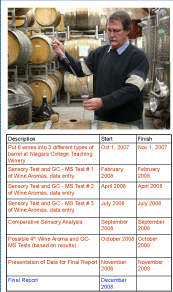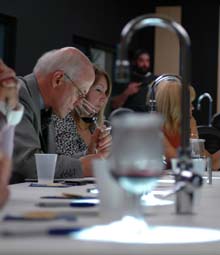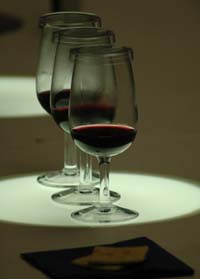|
|
 |
 |
|
Niagara College in partnership with Canadian Oak and the Ontario Center for Excellence have conducted Research on Canadian Oak As To It's Suitability For Enological Use |
 |
 |
 |
|
 |
 |
 |
 |
 |
 |
 |
 |
|
 |
 |
 |
 |
 |
 |
 |
 |
|
 |
 |
|
 |
|
|
|
 |
|
|
|
Sensory and Aromatic Comparison of Wine in Three Barrel Types: American Oak, French Oak, and Canadian Oak
|
|
|
|
|
|
|
|
The wine varietals that we are using in this project are Sauvignon Blanc, Cabernet Franc, Merlot, and Cabernet Sauvignon.
|
|
|
|
|
|
|
|
Isabelle Lesschaeve, Ag. Eng., Ph.D., Research Chair-Sensory and Consumer Science, Vineland Research and Innovation Centre designed the sensory tests conducted on Canadian oak barrels at Niagara College, September 2007. The GC-MS for a quantitative sensory analysis will be carried out with the assistance of Dr. George van der Merwe, from the University of Guelph.
|
|
|
|
|
|
|
|
|
 |
|
|
|
|
Research Project Description Start Finish
- Put 6 wines into 3 different types of barrel at Niagara College Teaching Winery - Harvest 2007
- Sensory Test and GC - MS Test # 2 of Wine Aromas, data entry - April 2008
- Sensory Test and GC - MS Test # 3 Aromas July 2008 July 2008
- Final Report December 2008
|
|
|
|
|
|
|
|
|
 |
|
|
|
|
|
|
A panel of experts selected from the wine industry perfomed blind tasting on the wines in April and July, using the sensory analysis criterion developed by Isabelle Lesschaeve, PhD. at the Vineland Research and Innovation Center. This data was entered into software created at Niagara College to evaluate the difference in a quantative manor.
|
|
|
|
|
|
|
 |
|
|
|
|
|
Outcomes: Only select wine regions can claim to having an entirely locally influenced product, and in terms of production, this also involves the aging of their wines in oak grown and coopered locally. The Niagara Region, for the first time, has a chance to become part of this group by using barrels produced from our own trees.
|
|
|
Niagara College hosts a tasting of the wine in itís three different barrels for the project. The panel of experts judging the wines assembles to begin the sensory analysis of the blind testing of these wine samples.
|
|
|
|
 |
|
|
|
|

